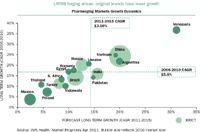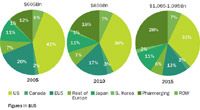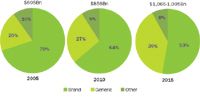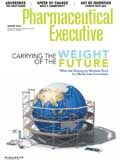Is the 'Emerging Market' a Dated Concept?
When it comes to the emerging markets, executing a few key elements of success are more important than ever.
As Big Pharma struggles through an endless cycle of market churn, a strategic question is whether the concept of an "emerging market" is a dated one. Many of these markets are no longer justemerging, but instead are firmly established, with the C-suite placing big bets on them as growth centers against diminished earnings over the next few years from the old mainstay markets of the US, Europe, and Japan. Drawing on insights from a May 31 roundtable with experts from IMS Health, our third-annual survey of the "pharmerging 17" adds some grouch to the gloss, concluding that profitability—the metric that counts—depends on how well companies deploy their portfolio strengths to separate themselves from the pack, drop that HQ comfort-zone mentality, and anticipate a growing list of built-in risks.

GETTY IMAGES: VICTOR HABBICK VISIONS
Like any passion play, the potential for big returns depends on the level of engagement, the cost of which is rising. Creating infrastructure, cultivating relationships, preserving a reputation for quality, and building a ground presence by mobilizing a large and conspicuous sales force is not cheap. At the same time, such investments don't mean that local payers—assuming you can identify them—will automatically pony up to pay for expensive brand drugs. The consensus is that "expensive"—in terms of commercial investment, portfolio positioning, and drug pricing—is an increasingly relative concept, dependent on a host of factors unique to each particular country. Making a decision about which emerging markets to enter requires as much of a studied self-examination of company assets and culture as it does an understanding of the market forces at work within a specific country. Going forward, it will take more than just showing up to make money.

Fastest-Growing Emerging Markets
Adaptability Pays
The traditional selling model for US- and European-based companies has been to launch innovative products at a premium price, which can be more or less maintained through the lifecycle of the drug. Following on that model, biologics and specialty drugs targeting orphan diseases—priced at an even higher premium, to make up for smaller patient populations—have been a winning strategy for many companies in mature markets, where healthcare spending is backed by a critical mass of affluence.
This is not necessarily so in the emerging markets. While India is said to have the world's largest middle class, annual household income for this segment is still only between $5,000 and $22,000, a modest amount in relation to what middle-class patients are able to pay for a typical innovative medicine in the West. In addition, that Indian middle class usually has to pay the full cost of a drug out of pocket, due to the absence of any government safety net. While other governments might pay for innovative treatments, most of the highest growth geographies start at a low base, and favor generics over brand drugs. Big Pharma has had some success in emerging markets by sticking to the brand and muscling out generic competitors, but that window is closing as governments start intervening to curb drug prices and promote the interests of local generics companies. "China is planning to benchmark brand drug prices to the local generic, even if the brands are on the essential drug list," said Marc Benoff, vice president, IMS Consulting Group. Russia and South Africa are two other examples of countries where government has said it will extend healthcare and drug reimbursement to greater swaths of the population, says Benoff, but it's unclear how these initiatives will be financed without significant European-style austerity measures.
Generics: Challenge or Opportunity?
Despite healthy growth forecasts for many of the 17 emerging markets surveyed by IMS, a closer look at the numbers may staunch initial enthusiasm: It's worth noting that market growth and pharma company growth is not the same thing. Spending on innovative brand drugs is expected to decrease across the board, with any gains offset by patent losses. Even though the global pharmaceutical market is predicted to cross the $1 trillion mark in 2015, approximately $400 billion to $430 billion, or 39 percent, will come from the sale of generic drugs. In 2010, generics accounted for just 27 percent of the global drug market.

Income Shifts
To capitalize on the skyrocketing generics spend, top pharmas have dusted off brands with expired patents and rejiggered them for emerging markets, often with the help of local generics players. In India alone, partnerships have been forged between Merck and Sun Pharmaceuticals, AstraZeneca and Torrent Pharmaceuticals, Bayer and Cadila Healthcare, GSK and Dr. Reddy's Laboratories, and Abbott paid $3.7 billion for key parts of Piramal Healthcare last year. But the branded generics game is not without risk; while some patients in emerging markets are willing to pay extra for the prestige (or presumed safety) that comes along with a drug manufactured by a Pfizer or a Merck, the margins necessary to make a deal worthwhile are beginning to face a crunch, as local governments intervene in negotiations or try to scale back reimbursement coverage.
Latin America, which represented 6 percent of the $856 billion global pharmaceutical industry in 2010, provides an example of the growing pains for pharma. Drug spending in the region is expected to rise by between 11 percent and 14 percent in the next five years, to as much as $82 billion by 2015. Brazil leads Latin America in terms of spending on drugs, and while that spending will increase, brand drugs will take a hit, despite a relatively large original brand market, says Michael Kleinrock, research director, IMS Institute for Healthcare Informatics. "Government policies will have longer-term impact on brand growth over the next five years ... a lot of the growth is essentially going to be volume-driven," he says.

Drug Spending by Geography
Indeed, brand drug prices in Latin America have been driven down by the adoption of international price referencing, where the lowest price wins. "Brazil's international price referencing significantly impacts the rest of Latin America," said John Brennick, director, worldwide market access, Janssen Global Services, at a panel at the Drug Information Association's (DIA) annual meeting in June. "Brazil takes the lowest price reference available," based on nine reference countries including Australia, Canada, France, Greece, Italy, New Zealand, Portugal, Spain, and the US or the drug's country of origin, said Brennick. That price can then represent "your product's maximum price for its entire patent life on the market in Latin American countries." Brand growth is also hampered by the fact that 79 percent of drug costs in Brazil are paid for out of pocket; Mexico's out-of-pocket percentage is even higher.
Some traditionally innovative drug-oriented companies have opted to buy in to Brazil's generics market. Last October, Pfizer bought 40 percent of Teuto, a Brazillian drug company, for $238 million. Sanofi bought Medley, and its portfolio of 189 generic products, for €500 million in 2009, although the deal was held up for a year by antitrust concerns.
Many of the growing pains present in Latin America hold true for other emerging market countries. Generic drug buy-ins are likely to continue, particularly with the shift in the profile of disease caused by things such as urbanization, diet, smoking, and rising life expectancy. "By 2030, the burden of disease in the emerging markets will look very similar to the burden in terms of chronic conditions in mature markets, "says David Campbell, senior principal, IMS Consulting Group. As the bulk of drug spending moves from acute disease to chronic disease, R&D-driven organizations are increasingly considering a play in branded generics, or pure generics sales. As an illustration of the pricing pressures in Brazil, and the appeal of generic buy-in, consider the following case presented at DIA by Alexandre Schiola, head of regional market access for Latin America at Bayer. Elan and Biogen Idec's Tysabri received regulatory approval in August 2008, and was eligible to be classified as a category 1 drug by the Brazilian Health Ministry. The wholesaler price in August 2008, as well as the accepted international price, was $2,400 per dose. The expected price in Brazil, with taxes and margins, was $3,900. But the price that received approval was $2,219.

Global Drug Spending by Segment
Examples like the one above can be impossibly frustrating. But challenges in pricing and market access have a way of weeding out companies without a stomach for change and innovation. Where some companies see a prohibitive set of circumstances, others see opportunity. In some cases, product process can be the source of innovation.
Reimbursement Innovation
"If you don't have a vision of how a drug is going to be reimbursed, you don't really have a drug," said Alberto Grignolo, corporate vice president, Parexel Consulting, at the DIA conference. There are ways to improve a drug's chances of gaining reimbursement, the first of which begins in the developmental stages. According to Raj Long, head of international regulatory, AMAC, GEM, Latin America, at Novartis, the onset of historically Western diseases, such as type 2 diabetes, hypertension, and cancer, demands mass-market access, which in turn generates a demand for affordable and reimbursable healthcare. A key mistake, says Long, is made when comparative effectiveness research (CER) is conducted during the final stages of product approval, in Phase III or later. Long says that the result of late-stage CER reflects a developed market gold standard, which becomes non-comparable in the local context.
"You can demonstrate superiority, and that's fine, you might get approval, but you won't get reimbursed, because the products you compared aren't available" in a given emerging market, Long tells Pharm Exec. Additionally, the dose titration target for mature markets may not jibe with emerging market standards, says Long. By commencing CER on dosage, safety, and efficacy during Phase II, sponsors can better identify payer-oriented endpoints, seek and combine payer/regulator/sponsor input, and identify local practices and medical standards, Long says. This helps to create a "local system" value, rather than just claiming marginal improvements in efficacy in terms of global value.
It's also important to remember that innovative drugs do get reimbursed in some emerging markets, particularly the most innovative therapies. Bayer was able to gain reimbursement on Nexavar, an innovative cancer drug, in Korea, a notoriously difficult reimbursement environment, earlier this year. Compelling evidence relevant to the disease profile for kidney cancer in Korea as well as an aggressive clinician outreach strategy helped do the trick.
Another way to gain reimbursement favor in emerging markets is to invest in local manufacturing, as the political preferences for homegrown products pile up. Perhaps the most famous call for local production over the last year came from Russian Prime Minister Vladimir Putin, who, according to a report in the Moscow Times, said he wanted "90 percent of Russia's vital medicines, and 50 percent of its medical equipment to be domestically produced by 2020." Pharm Exec's IMS panel agreed that local investment can sometimes help to open reimbursement doors. "There are discussions around setting up bio parks to stimulate new industry [in Russia], says Campbell, but that presents new challenges, since Russia doesn't have established Good Manufacturing Practices (GMP). "A lot of organizations don't want to manufacture in Russia, because you can't export out" without GMP compliance. "Other organizations are making decisions about whether to build manufacturing plants, hedging on the fact that government may mandate local manufacturing to be included on its central drug list for any new national drug insurance scheme that goes forward," says Campbell. But that's a risky bet, since it could turn out that local manufacturing isn't mandated, but instead receives preferential pricing, which could in turn be offset by importation taxes.
For IMS's tier 1 and 2 markets—China plus Brazil, Russia and India—"making some direct investment, I think, has a real impact," said Benoff. But for the 13 tier 3 markets—which include Argentina, Egypt, Indonesia, Mexico, Pakistan, Poland, Romania, South Africa, Thailand, Turkey, Ukraine, Venezuela, and Vietnam—"the ability to drive local investment is much less significant," since "the tradeoffs aren't as strong."
Putting Risk in a Basket
One of the crucial aspects of selling in the pharmerging space is the assets in a company's portfolio, and how it changes from market to market. "The opportunity in each of the individual pharmerging markets is very different depending on portfolio," says Campbell, adding that GlaxoSmithKline, and several other companies, have a "very localized portfolio in India versus their global portfolio," a strategy primarily due to the prevalence of out-of-pocket payment from patients. "The opportunity depends on whether you're trying to sell high-priced innovative products ... or branded or unbranded generics."
Aside from portfolio customizing for specific markets, industry must also prepare itself for some volatility in how countries see this squaring with their own priorities. "Companies are essentially realigning their definitions to match this [emerging markets] basket approach, which mitigates some of the risk," says Kleinrock. "We've seen growth performance swings in China of 10 percent or 12 percent in a single year. Companies are increasingly talking about putting these countries together, to curb variable growth trends. That's helpful in terms of investment return." Nevertheless, marquee growth rates among local players in emerging markets can drum up artificially high performance expectations at headquarters, and some of the multinationals fail to achieve similar growth rates, adds Kleinrock. A long-term perspective and tolerance of the occasional launch failure is the best way that HQ can overcome this trend. It is also important to agree on just where HQ should set benchmarks for progress—measuring performance against local firms is not always the right indicator to chart success.
Leveraging the portfolio successfully should also recognize rates of disease morbidity and mortality unique to a given market, since disease prevalence can vary dramatically between countries. In Russia, for instance, cardiovascular disease and metabolic disorders represent the most pressing health concerns; in India, infectious diseases are top of mind; and in Brazil, China, and Mexico, neuropsychiatric disorders represent the largest healthcare costs.
Leading a Best Practices Culture
So, how is the C-suite responding to growth opportunities in emerging markets? "Most companies start out with a legacy footprint—countries where the parent organization has been strong in the past—but now the local affiliates are saying, 'Okay, we are beating the competition in Brazil so can we launch in other Portuguese-speaking markets?' Or, 'We're in Asia; are there other markets in Asia that have similar demographics and disease profiles that we can move into?'" says Campbell. "Everyone is chasing China," but beyond that, it depends on the company and its management.
In terms of organization, many companies have elected to combine the emerging markets into a single entity that reports up to the CEO, taking leadership out of the regions, says Benoff. "But a lot of the tier 3 pharmerging countries still stay in the regions, and to me, that's a signal of where efforts are the most focused." In this scenario, "you're seeing the four BRIC countries, plus maybe Turkey or Mexico, getting most of the attention" from top brass, he says. Chris Nickum, vice president, IMS Consulting Group, says companies are still configuring internal reporting structures for the smaller emerging markets. "I think all companies have good intentions of trying to take commercial best practices from around the globe and putting them into use in those markets," says Nickum. "They're still working out accountability for some of the Tier 3 markets: Who makes what decision, in what order, and under what workup for allocating resources?"
In terms of expertise on the ground, "the local general manager is going to know the most about the market," according to Nickum. "But they may not see everything else the company is doing commercially, around the rest of the world. What we see a lot of times is that the GM is doing one thing, headquarters is doing another, and they don't meet in between." If global multinationals are serious about maintaining a long-term presence in emerging markets, they will need to start incorporating local talent in to the executive ranks. Much like politics, all business is local.
In summary, for a successful launch in an emerging market, Nickum says organizational alignment is No. 1, followed by a clear value proposition, which may include pharmacoeconomic data and CER, patient assistance programs, and a commitment to diagnostic testing. It is equally important to use the asset provided by a distinct offering through the portfolio to build currency with local stakeholders.
Big Pharma leadership has demonstrated a desire to learn about new markets, and to do their homework, says Campbell, but they haven't yet shown a "desire to innovate in terms of the commercial model." Nickum says true innovation often requires "new systems and capabilities;" some of these are beginning to get rolled out. "You're starting to see some of the big multinationals roll out global centers of excellence for things such as e-detailing or tele-detailing," he says.
Checklist for Change
Long-term success in emerging markets thus requires a unique skill set, one that requires agility and the willingness to adapt to new conditions on the ground. Consider the following levers of influence before executing your strategy in each market:
- Prioritize investment. Are you focusing investment primarily on manufacturing, R&D, or promotion? Local government, of course, can drive the decision on all three of these options, but once the decision is made, make sure the investment correlates with stated objectives.
- Know thyself. The best way to succeed in emerging markets is to understand the core strengths and value proposition your company can bring to the table. Organize your portfolio to meet the demands of each market.
- Investigate key players. Don't assume that physicians are the key to decisions about what drug gets prescribed, or purchased. Patient decisions and reimbursement coverage may function independently. Cultivating government and the state-owned organizations that often surround it is another useful point of introduction to the decision set.
- Understand the information needs of the market. Endpoints, comparative effectiveness research, health equity, and observational research typical of mature market drug launching may not align with emerging markets standards. For example, an economic study produced in the US or Europe to demonstrate how use of a drug reduces hospitalization costs may be irrelevant in Russia, where daily hospital charges are sometimes lower than the cost of out-patient treatment with an innovative drug. Build contacts with local academic institutions familiar with health practices and link up with payers as early as possible to establish the threshold for evidence.
- Listen to the locals. Success in one market does not guarantee expertise in another. Give local affiliates a seat at the table to avoid blind-siding local expertise when key decisions are being made at HQ. Make sure key business support functions like manufacturing are not "US-centric" or "Euro-centric" but are properly aligned globally and thus can address any special needs in the emerging markets.
- A strong reputation is a major business asset. In many emerging markets, Big Pharma brands are associated with quality. Maintaining that association is vital to long-term success. Forging a local identity as a local company by partnering around issues such as quality and prevention is another tool that can counter the growing tendency toward bias in government polices to promote the commercial interests of home-based companies.

The Misinformation Maze: Navigating Public Health in the Digital Age
March 11th 2025Jennifer Butler, chief commercial officer of Pleio, discusses misinformation's threat to public health, where patients are turning for trustworthy health information, the industry's pivot to peer-to-patient strategies to educate patients, and more.
Navigating Distrust: Pharma in the Age of Social Media
February 18th 2025Ian Baer, Founder and CEO of Sooth, discusses how the growing distrust in social media will impact industry marketing strategies and the relationships between pharmaceutical companies and the patients they aim to serve. He also explains dark social, how to combat misinformation, closing the trust gap, and more.
Applying Porter’s Five Forces to Portfolio Management in Pharmaceutical R&D: A Strategic Roadmap
March 17th 2025The increasing costs and complexity of R&D in the pharmaceutical industry have necessitated the adoption of strategic portfolio management to optimize resource allocation and enhance competitive advantage.